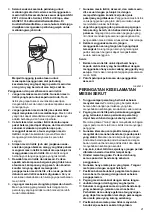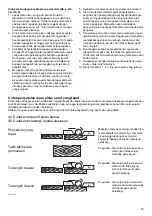
8
5.
Maintain power tools and accessories. Check for
misalignment or binding of moving parts,
breakage of parts and any other condition that
may affect the power tool’s operation. If damaged,
have the power tool repaired before use.
Many
accidents are caused by poorly maintained power
tools.
6.
Keep cutting tools sharp and clean.
Properly
maintained cutting tools with sharp cutting edges are
less likely to bind and are easier to control.
7.
Use the power tool, accessories and tool bits etc.
in accordance with these instructions, taking into
account the working conditions and the work to
be performed.
Use of the power tool for operations
different from those intended could result in a
hazardous situation.
8.
Keep handles and grasping surfaces dry, clean
and free from oil and grease.
Slippery handles and
grasping surfaces do not allow for safe handling and
control of the tool in unexpected situations.
9.
When using the tool, do not wear cloth work
gloves which may be entangled.
The entanglement
of cloth work gloves in the moving parts may result in
personal injury.
Service
1.
Have your power tool serviced by a qualified
repair person using only identical replacement
parts.
This will ensure that the safety of the power tool
is maintained.
2.
Follow instruction for lubricating and changing
accessories.
GEB167-1
PLANER SAFETY WARNINGS
1.
Wait for the cutter to stop before setting the tool
down.
An exposed rotating cutter may engage the
surface leading to possible loss of control and serious
injury.
2.
Hold the power tool by insulated gripping
surfaces, because the cutter may contact its own
cord.
Cutting a “live” wire may make exposed metal
parts of the power tool “live” and could give the
operator an electric shock.
3.
Use clamps or another practical way to secure and
support the workpiece to a stable platform.
Holding
the workpiece by your hand or against the body leaves
it unstable and may lead to loss of control.
4.
Rags, cloth, cord, string and the like should never
be left around the work area.
5.
Avoid cutting nails. Inspect for and remove all
nails from the workpiece before operation.
6.
Use only sharp blades. Handle the blades very
carefully.
7.
Be sure the blade installation bolts are securely
tightened before operation.
8.
Hold the tool firmly with both hands.
9.
Keep hands away from rotating parts.
10.
Before using the tool on an actual workpiece, let it
run for a while. Watch for vibration or wobbling
that could indicate poor installation or a poorly
balanced blade.
11.
Make sure the blade is not contacting the
workpiece before the switch is turned on.
12.
Wait until the blade attains full speed before
cutting.
13.
Always switch off and wait for the blades to come
to a complete stop before any adjusting.
14.
Never stick your finger into the chip chute. Chute
may jam when cutting damp wood. Clean out
chips with a stick.
15.
Do not leave the tool running. Operate the tool
only when hand-held.
16.
Always change both blades or covers on the
drum, otherwise the resulting imbalance will
cause vibration and shorten tool life.
17.
Use only Makita blades specified in this manual.
18.
Always use the correct dust mask/respirator for
the material and application you are working with.
SAVE THESE INSTRUCTIONS.
WARNING:
DO NOT let comfort or familiarity with product (gained
from repeated use) replace strict adherence to safety
rules for the subject product.
MISUSE or failure to follow the safety rules stated in
this instruction manual may cause serious personal
injury.
FUNCTIONAL DESCRIPTION
CAUTION:
• Always be sure that the tool is switched off and
unplugged before adjusting or checking function on the
tool.
Adjusting depth of cut (Fig. 1)
Depth of cut may be adjusted by simply turning the knob
on the front of the tool so that the pointer points the
desired depth of cut.
Switch action (Fig. 2)
CAUTION:
• Before plugging in the tool, always check to see that
the switch trigger actuates properly and returns to the
"OFF" position when released.
For tool with lock button
CAUTION:
• Switch can be locked in "ON" position for ease of
operator comfort during extended use. Apply caution
when locking tool in "ON" position and maintain firm
grasp on tool.
To start the tool, simply pull the switch trigger. Release the
switch trigger to stop.
For continuous operation, pull the switch trigger and then
push in the lock button.
To stop the tool from the locked position, pull the switch
trigger fully, then release it.
For tool with lock-off button
To prevent the switch trigger from being accidentally
pulled, a lock-off button is provided.
To start the tool, depress the lock-off button and pull the
switch trigger. Release the switch trigger to stop.









































